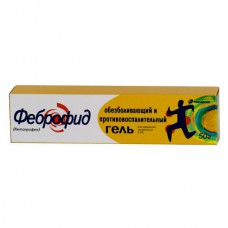Expiration date: 01/2026
The composition and form of issue:
Gel for external use, 100 gcontains:
Ketoprofen a lysine salt of 2, 5 g
excipients: polyethylene glycol metilgidroksibenzoat propilgidroksibenzoat karbomer triethanolamine purified water
the aluminum tubes to 30 or 50 grams in a cardboard bundle 1 tuba.
Description of dosage form:
From colorless to pale yellowish gel, clear or slightly opalescent.
Characteristic:
Belongs to the group of NSAIDs.
Pharmacological action:
In the form of gel provides local treatment of lesions of joints, tendons, ligaments, muscles, skin, veins, lymphatic vessels and lymph nodes. When the joint syndrome causes a weakening of pain in the joints at rest and when moving, reducing morning stiffness and swelling of the joints.
Pharmacokinetics:
It penetrates through the skin. Bioavailability of gel-about 5%. The whole part of Ketoprofen binds to plasma proteins by approximately 99%. Metabolized in the liver. About 80% of the dose is excreted in the urine as metabolites, less than 10% — unchanged. Does not cumulate in the body.
Indications:
As a local analgesic and anti-inflammatory drug for symptomatic treatment: pain in the spine, neuralgia, myalgia inflammatory-degenerative diseases of the musculoskeletal system, arthritis, bursitis, synovitis, tendinitis, lumbago uncomplicated trauma, particularly sports injuries, dislocations, sprains or torn ligaments and tendons, bruises, post-traumatic pain in a combination therapy in inflammatory diseases of veins (phlebitis, periflebit), lymphatic vessels, lymph nodes (limphangit, superficial lymphadenitis).
Contraindications:
Hypersensitivity to Ketoprofen and/or other constituent parts of the drug, as well as to other NSAIDs and acetylsalicylic acid (bronchospasm may develop) wet dermatoses, eczema, infected abrasions, wounds, burns pregnancy (III trimester), lactation.
Application during pregnancy and breast-feeding:
Contraindicated in pregnancy (III trimester) in the first and second trimester only if necessary. At the time of treatment should stop breastfeeding.
Side effect:
Allergic reactions, skin hyperemia, photosensitization, skin exanthema, purpura.
Drug interaction:
In cases of frequent and prolonged use, there may be symptoms of interaction with other drugs, such as systemic use.
Co-administration with other nonsteroidal anti-inflammatory drugs, GCS, ethanol, corticotropin can lead to ulcers and the development of gastrointestinal bleeding.
Co-administration with oral anticoagulants, heparin with thrombolytic drugs, antiplatelet agents, cefoperazone, cefamandole increases the risk of bleeding.
Reduces the effect of antihypertensive drugs and diuretics (inhibition of PG synthesis).
Increases hypoglycemic effect of insulin and oral hypoglycemic drugs (requires the recalculation of doses).
Joint appointment with sodium valproate causes a violation of platelet aggregation. Increases plasma concentrations of verapamil and nifedipine.
Method of application and doses:
Outwardly. Apply a small amount (3-5 cm) of gel to the sore spot and RUB it easily 2-3 times a day.
In applying a dry bandage is not necessary, because the gel is well absorbed through the skin, has no odor, does not contain dyes, leaves no greasy stains, does not stain clothes.
Special instruction:
To avoid getting the drug on mucous membranes and eyes.
Do not use on damaged skin.
During long-term use, caution should be exercised in patients with severe liver and/or kidney failure.
In case of rash, it is necessary to stop treatment and conduct appropriate therapy.


